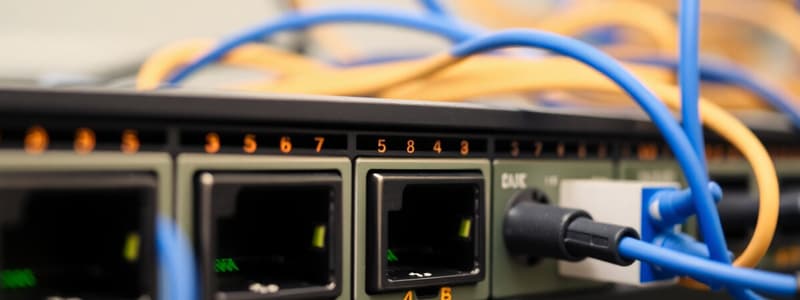Podcast
Questions and Answers
What type of network covers a small geographic area such as a home or office?
What type of network covers a small geographic area such as a home or office?
- LAN (Local Area Network) (correct)
- WAN (Wide Area Network)
- PAN (Personal Area Network)
- MAN (Metropolitan Area Network)
Which component is responsible for managing data flow within a network?
Which component is responsible for managing data flow within a network?
- End Device
- Intermediary Device (correct)
- Packet
- Network Interface Card
What does quality of service (QoS) in a network prioritize?
What does quality of service (QoS) in a network prioritize?
- Bandwidth allocation
- User authentication
- Voice and video data (correct)
- Data encryption
Which of the following trends involves employees using personal devices for company resources?
Which of the following trends involves employees using personal devices for company resources?
What is a common external threat to network security?
What is a common external threat to network security?
What type of network is characterized by connected LANs over large geographic areas?
What type of network is characterized by connected LANs over large geographic areas?
Which term describes the layout of a network?
Which term describes the layout of a network?
What is the primary benefit of the larger address space in IPv6?
What is the primary benefit of the larger address space in IPv6?
How do hosts send packets to devices on different networks?
How do hosts send packets to devices on different networks?
What does the host routing table contain?
What does the host routing table contain?
Which of the following correctly describes the purpose of network protocols?
Which of the following correctly describes the purpose of network protocols?
Which component is responsible for storing the router's startup configuration?
Which component is responsible for storing the router's startup configuration?
What is the correct order of data encapsulation from application data to the data link layer?
What is the correct order of data encapsulation from application data to the data link layer?
What is the primary function of an IP address in a computer network?
What is the primary function of an IP address in a computer network?
What is the first step in the router boot-up process?
What is the first step in the router boot-up process?
Which of the following address types allows for communication from one device to all devices on the network?
Which of the following address types allows for communication from one device to all devices on the network?
Which security goal is concerned with preventing unauthorized access to data?
Which security goal is concerned with preventing unauthorized access to data?
What is the purpose of a subnet mask in IPv4 addressing?
What is the purpose of a subnet mask in IPv4 addressing?
In which of the following network types is the data transmission typically faster?
In which of the following network types is the data transmission typically faster?
Which layer of the OSI model is responsible for establishing, managing, and terminating sessions?
Which layer of the OSI model is responsible for establishing, managing, and terminating sessions?
What is the correct description of a public IPv4 address?
What is the correct description of a public IPv4 address?
Which of the following best describes the role of MAC addresses in networking?
Which of the following best describes the role of MAC addresses in networking?
Which memory type in a router holds the IOS?
Which memory type in a router holds the IOS?
What is typically involved in the initial setup of a router?
What is typically involved in the initial setup of a router?
What emerging trend provides flexibility for users to access networks using personal devices?
What emerging trend provides flexibility for users to access networks using personal devices?
Which statement is true regarding TCP/IP model layers?
Which statement is true regarding TCP/IP model layers?
What is the total number of usable hosts in a /27 subnet?
What is the total number of usable hosts in a /27 subnet?
What is the subnet mask for an address that supports 50 hosts?
What is the subnet mask for an address that supports 50 hosts?
Which of the following is a benefit of Variable Length Subnet Masking (VLSM)?
Which of the following is a benefit of Variable Length Subnet Masking (VLSM)?
Which method is commonly used to calculate subnet ranges?
Which method is commonly used to calculate subnet ranges?
What is a disadvantage of manually configured routes in the routing table?
What is a disadvantage of manually configured routes in the routing table?
What is the purpose of subnetting?
What is the purpose of subnetting?
What is the function of ICMP in networking?
What is the function of ICMP in networking?
Which of the following IP ranges is classified as a private address?
Which of the following IP ranges is classified as a private address?
In a subnet mask denoted as /24, how many bits are allocated for the network portion?
In a subnet mask denoted as /24, how many bits are allocated for the network portion?
Which address type is automatically configured when DHCP fails?
Which address type is automatically configured when DHCP fails?
What is the maximum number of subnets that can be created if 4 bits are borrowed?
What is the maximum number of subnets that can be created if 4 bits are borrowed?
Which class of IP addresses is used for medium-sized networks?
Which class of IP addresses is used for medium-sized networks?
Which tool would you use to check the connectivity to a particular host?
Which tool would you use to check the connectivity to a particular host?
Which range is reserved for teaching purposes?
Which range is reserved for teaching purposes?
What does CIDR stand for?
What does CIDR stand for?
A LAN (Local Area Network) connects large geographic areas like cities and countries.
A LAN (Local Area Network) connects large geographic areas like cities and countries.
The internet is a global collection of LANs and WANs connected using various media.
The internet is a global collection of LANs and WANs connected using various media.
Intermediary devices, such as routers and switches, are responsible for managing data flow in a network.
Intermediary devices, such as routers and switches, are responsible for managing data flow in a network.
Quality of Service (QoS) in networking is about minimizing network costs.
Quality of Service (QoS) in networking is about minimizing network costs.
BYOD stands for Bring Your Own Device, encouraging employees to use personal devices for work.
BYOD stands for Bring Your Own Device, encouraging employees to use personal devices for work.
Fault tolerance in a network means it cannot recover from failures.
Fault tolerance in a network means it cannot recover from failures.
Packet switching is a method that improves fault tolerance by splitting traffic into packets.
Packet switching is a method that improves fault tolerance by splitting traffic into packets.
A default static route is defined as a route that forwards all packets without a more specific match, using the address 0.0.0.0/0.
A default static route is defined as a route that forwards all packets without a more specific match, using the address 0.0.0.0/0.
Dynamic routing protocols require manual configuration to discover remote networks.
Dynamic routing protocols require manual configuration to discover remote networks.
Link-State protocols build a complete topology map of the network and use algorithms like Dijkstra's to compute the shortest path.
Link-State protocols build a complete topology map of the network and use algorithms like Dijkstra's to compute the shortest path.
Floating static routes are used as primary routes that are always active.
Floating static routes are used as primary routes that are always active.
Distance-Vector protocols have a complete view of the network topology.
Distance-Vector protocols have a complete view of the network topology.
Protocols only govern message formatting.
Protocols only govern message formatting.
HTTP is a protocol used for web communications.
HTTP is a protocol used for web communications.
IP Addresses assign source and destination addresses for end-to-end delivery.
IP Addresses assign source and destination addresses for end-to-end delivery.
Encapsulation refers to the process of adding data segments to the application layer.
Encapsulation refers to the process of adding data segments to the application layer.
A LAN typically covers a large geographic area with high speeds.
A LAN typically covers a large geographic area with high speeds.
Cloud computing allows access to resources remotely.
Cloud computing allows access to resources remotely.
Data link frames in local network access are sent via a router.
Data link frames in local network access are sent via a router.
MAC addresses are used for end-to-end delivery between devices on the same network.
MAC addresses are used for end-to-end delivery between devices on the same network.
Confidentiality in network security ensures authorized access to data.
Confidentiality in network security ensures authorized access to data.
IPv4 addresses are 128-bit numbers divided into 4 octets.
IPv4 addresses are 128-bit numbers divided into 4 octets.
The default gateway is used for sending packets to devices on the same network.
The default gateway is used for sending packets to devices on the same network.
RAM in a router stores the startup configuration.
RAM in a router stores the startup configuration.
IPv6 eliminates the need for NAT.
IPv6 eliminates the need for NAT.
A multicast address allows one-to-all communication.
A multicast address allows one-to-all communication.
Router routing tables can contain directly connected routes.
Router routing tables can contain directly connected routes.
The load IOS process typically happens from RAM to Flash memory.
The load IOS process typically happens from RAM to Flash memory.
IPv4 addresses can be classified as public or private.
IPv4 addresses can be classified as public or private.
The bootstrap program is stored in RAM.
The bootstrap program is stored in RAM.
A subnet mask determines the boundary between the network and host portions of an IP address.
A subnet mask determines the boundary between the network and host portions of an IP address.
The loopback address range is 127.0.0.0/8.
The loopback address range is 127.0.0.0/8.
Class A IP addresses typically support large networks from 128.0.0.0 to 191.255.255.255.
Class A IP addresses typically support large networks from 128.0.0.0 to 191.255.255.255.
CIDR allows more rigid subnetting options.
CIDR allows more rigid subnetting options.
The IP address range 169.254.0.0/16 is designated as a link-local address.
The IP address range 169.254.0.0/16 is designated as a link-local address.
Subnetting increases the number of hosts per subnet while decreasing the number of subnets.
Subnetting increases the number of hosts per subnet while decreasing the number of subnets.
The subnet mask for a /24 prefix allows for 256 addresses.
The subnet mask for a /24 prefix allows for 256 addresses.
ICMP is used primarily for diagnostic tools such as ping and traceroute.
ICMP is used primarily for diagnostic tools such as ping and traceroute.
A static IP address is assigned automatically by DHCP.
A static IP address is assigned automatically by DHCP.
The binary to decimal conversion involves calculating each bit's value using powers of 2.
The binary to decimal conversion involves calculating each bit's value using powers of 2.
Testing tools like ping can help verify connectivity to both local and remote hosts.
Testing tools like ping can help verify connectivity to both local and remote hosts.
Flashcards
LAN
LAN
A network covering a small geographic area, like a home or office. It typically has high bandwidth and a single administrator.
WAN
WAN
A network connecting LANs across a large geographic area, like cities or countries. Managed by multiple providers and typically slower than LAN.
Network Security Threats
Network Security Threats
Possible dangers to a network, both internal (e.g., employee error) and external (e.g., hacking, viruses).
Fault Tolerance
Fault Tolerance
Signup and view all the flashcards
Network Components
Network Components
Signup and view all the flashcards
Network Communication
Network Communication
Signup and view all the flashcards
BYOD
BYOD
Signup and view all the flashcards
Protocols
Protocols
Signup and view all the flashcards
Data Encapsulation
Data Encapsulation
Signup and view all the flashcards
IP Address
IP Address
Signup and view all the flashcards
MAC Address
MAC Address
Signup and view all the flashcards
OSI Model
OSI Model
Signup and view all the flashcards
TCP/IP Model
TCP/IP Model
Signup and view all the flashcards
Network Security Goals
Network Security Goals
Signup and view all the flashcards
LAN vs. WAN
LAN vs. WAN
Signup and view all the flashcards
Emerging Trends
Emerging Trends
Signup and view all the flashcards
IPv6 Address Space
IPv6 Address Space
Signup and view all the flashcards
IPv6 Header Structure
IPv6 Header Structure
Signup and view all the flashcards
IPv6 and NAT
IPv6 and NAT
Signup and view all the flashcards
Default Gateway
Default Gateway
Signup and view all the flashcards
Host Routing Table
Host Routing Table
Signup and view all the flashcards
Router Routing Table
Router Routing Table
Signup and view all the flashcards
Router Components: RAM
Router Components: RAM
Signup and view all the flashcards
Router Components: NVRAM
Router Components: NVRAM
Signup and view all the flashcards
Router Components: Flash Memory
Router Components: Flash Memory
Signup and view all the flashcards
Router Components: ROM
Router Components: ROM
Signup and view all the flashcards
Subnet Mask
Subnet Mask
Signup and view all the flashcards
Magic Number
Magic Number
Signup and view all the flashcards
Static Routing
Static Routing
Signup and view all the flashcards
What are the advantages of static routing?
What are the advantages of static routing?
Signup and view all the flashcards
10.0.0.0/8
10.0.0.0/8
Signup and view all the flashcards
172.16.0.0/12
172.16.0.0/12
Signup and view all the flashcards
192.168.0.0/16
192.168.0.0/16
Signup and view all the flashcards
Loopback Address
Loopback Address
Signup and view all the flashcards
Link-Local Address
Link-Local Address
Signup and view all the flashcards
Test-Net Address
Test-Net Address
Signup and view all the flashcards
Class A Network
Class A Network
Signup and view all the flashcards
Class B Network
Class B Network
Signup and view all the flashcards
Class C Network
Class C Network
Signup and view all the flashcards
What is CIDR?
What is CIDR?
Signup and view all the flashcards
Default Static Route
Default Static Route
Signup and view all the flashcards
Dynamic Routing
Dynamic Routing
Signup and view all the flashcards
Distance-Vector Protocol
Distance-Vector Protocol
Signup and view all the flashcards
Link-State Protocol
Link-State Protocol
Signup and view all the flashcards
Network Types: LAN
Network Types: LAN
Signup and view all the flashcards
Network Types: WAN
Network Types: WAN
Signup and view all the flashcards
Network Components: End Devices
Network Components: End Devices
Signup and view all the flashcards
Network Components: Intermediary Devices
Network Components: Intermediary Devices
Signup and view all the flashcards
What are network protocols?
What are network protocols?
Signup and view all the flashcards
What's data encapsulation?
What's data encapsulation?
Signup and view all the flashcards
What is an IP address?
What is an IP address?
Signup and view all the flashcards
What is a MAC address?
What is a MAC address?
Signup and view all the flashcards
What are LAN and WAN?
What are LAN and WAN?
Signup and view all the flashcards
Emerging Network Trends
Emerging Network Trends
Signup and view all the flashcards
What is Subnetting?
What is Subnetting?
Signup and view all the flashcards
Network Portion vs. Host Portion
Network Portion vs. Host Portion
Signup and view all the flashcards
Borrowing Host Bits
Borrowing Host Bits
Signup and view all the flashcards
Number of Subnets Formula
Number of Subnets Formula
Signup and view all the flashcards
What is ICMP?
What is ICMP?
Signup and view all the flashcards
What is Traceroute?
What is Traceroute?
Signup and view all the flashcards
Binary to Decimal Conversion
Binary to Decimal Conversion
Signup and view all the flashcards
Decimal to Binary Conversion
Decimal to Binary Conversion
Signup and view all the flashcards
Static IP vs. Dynamic IP
Static IP vs. Dynamic IP
Signup and view all the flashcards
Study Notes
Chapter 1: Introduction to Networks
- Networks connect devices globally for communication, learning, work, and entertainment.
- Communication methods include texting, social media, online collaboration, blogs, and gaming.
Chapter 2: Types of Networks
- LAN (Local Area Network): Covers a small geographic area (home, office, etc.). High-speed bandwidth, single administration.
- WAN (Wide Area Network): Connects LANs over large geographic areas (cities, countries). Managed by multiple service providers, slower speeds.
- Internet: A global network of interconnected LANs and WANs using copper, fiber optic, and wireless media.
Network Components
- End Devices: Where messages originate or are received (e.g., computers, phones).
- Intermediary Devices: Manage data flow (e.g., routers, switches, firewalls).
- Media Types: Copper cables, fiber optics, wireless.
Network Architectures
- Fault Tolerance: Redundancy in a network to minimize failures.
Chapter 2/1: Key Topics on Networking
- Communication Rules: Require a sender, receiver, and communication channel (medium).
- Protocols govern message formatting, timing, delivery, and acknowledgment.
- Data is encoded and encapsulated in protocol layers.
Network Protocols and Standards
- Protocols ensure interoperability using layers like TCP/IP and OSI.
- Common protocols include HTTP for web communication, TCP for managing data segments, and IP for assigning source and destination addresses.
- Protocol suites (e.g., TCP/IP) define communication standards.
Data Encapsulation
- Data is encapsulated as it moves through network layers, from application to transport, network, and data link layers.
Addressing
- IP Address: Identifies source and destination for end-to-end delivery.
- MAC Address: Provides data link delivery between devices on the same network.
Local and Remote Network Access
- Local Access: Data link frames are sent directly between devices.
- Remote Access: Frames are sent via a default gateway (e.g., router) for IP packets.
Reference Models
- OSI Model: Seven layered model (Application, Presentation, Session, Transport, Network, Data Link, Physical).
- TCP/IP Model: Four layered model (Application, Transport, Internet, Network Access).
Network Security
- Goals: Confidentiality (authorized access), Integrity (prevent data alteration), and Availability (reliable access for authorized users).
- Threats: External (viruses, attacks, data theft), Internal (human errors, malicious activity).
Network Types
- LAN (Local Area Network): Small geographic area, high speed.
- WAN (Wide Area Network): Large geographic area, slower speed.
Networking Trends
- BYOD (Bring Your Own Device): Employees use personal devices for work.
- Cloud Computing: Data and resources stored and accessed over the internet.
- Online Collaboration and Video Communication: Tools for virtual teamwork (e.g., Cisco WebEx and TelePresence).
- Smart Homes: Technology integration into appliances.
Chapter 2/2: Configure Network Operating System
- Cisco IOS: Operating system for network devices (routers, switches).
- CLI (Command-Line Interface): For device management.
- Access Methods: Console Port (direct physical access), Secure Shell (SSH) (encrypted remote access), Telnet (not secure).
- Command Modes: User EXEC (basic view-only), Privileged EXEC (advanced configuration), Global Configuration (device-wide settings), Sub-configuration Modes (interface, line).
- Important Commands: To move between modes, save configurations.
- Security Configuration: Secure privileged EXEC and console access.
Chapter 3 Networking Layer Overview
- Purpose: Provides end-to-end communication, handles addressing, encapsulation, routing, and de-encapsulation.
- Protocols: IPv4 and IPv6.
- IP characteristics: Connectionless protocol, best-effort delivery, media independent.
- IPv4 Header: Contains version, time to live, source/destination IP.
Chapter 4 Addressing Basics
- IPv4 addressing: 32-bit binary, divided into 4 octets.
- Composed of: Network portion, Host portion, Subnet mask (determines the boundary between network and host portions).
- Address Types: Unicast (one-to-one communication), Broadcast (one-to-all communication), Multicast (one-to-group communication).
- IPv4 Address Categories: Public (routable on the internet), Private (not routable externally).
Special Use Addresses and IPv4 Address Classes
- Special Use Addresses: Loopback (127.0.0.0/8), Link-Local (169.254.0.0/16), Test-Net (192.0.2.0/24).
- IPv4 Address Classes: A, B, and C (differ in the number of bits allocated to network and host portions).
CIDR and Subnetting
- CIDR (Classless Inter-Domain Routing): Flexible subnetting.
- Subnetting: Dividing a large network into smaller sub-networks to optimize IP usage.
ICMP and Connectivity Verification
- ICMP (Internet Control Message Protocol): Used for diagnostic tools like ping and traceroute.
Conversions Between Binary and Decimal
- Binary-to-decimal: Calculate each bit's value using powers of 2.
- Decimal-to-binary: Subtract the largest power of 2 smaller than the number, and repeat.
Practical Usage
- Static IP: Fixed IP address for devices.
- Dynamic IP: Assigned automatically.
Testing Tools
- Ping: Used for testing connectivity.
- Traceroute: Used for displaying the path and delay for packets.
Studying Focus for Subnetting
- Understand how to calculate subnet, mask bits (prefixes), address types, and differences between private, public, unicast addresses.
- Practice testing connectivity, and how ping/traceroute works.
- Learn how subnetting optimizes IP allocation.
Chapter 5 Subnetting
- Subnetting: Dividing a large network into smaller subnetworks.
- Principles: Network vs. Host portions, Borrowing host bits (more bits borrowed → more subnets but fewer hosts per subnet).
- Formulas: Number of subnets, hosts per subnet.
- VLSM (Variable Length Subnet Masking): Using different subnet masks optimize IP address usage.
Chapter 6 Static Routing Basics
- Definition: Manually configured routes for a routing table.
- Advantages: Enhanced security, resource efficient, predictable paths.
- Disadvantages: Time-consuming to configure and maintain, not scalable for growing networks.
- Types: Standard static route, default static route (Gateway of Last Resort), floating static route
- Use Cases: Primarily for small, stable networks, or stubs networks.
Chapter 7: Dynamic Routing
- Definition: Dynamic routing protocols automatically discover and maintain routing information.
- Purpose: To discover remote networks and adjust routes, determine the best path and maintain up-to-date routing tables.
- Advantages: Reduces administrative overhead, automatically adapts to topology changes, suitable for complex networks.
- Disadvantages: Requires more router resources (CPU, bandwidth), slower convergence than static routing.
- Types: Distance-vector protocols (e.g., RIP, EIGRP), Link-state protocols (e.g., OSPF, IS-IS).
- Key Metrics: Hops, bandwidth, delay, reliability, load in routing protocol decisions.
Chapter 8 OSPF
- Definition: Open Shortest Path First (OSPF) a link-state routing protocol within an Autonomous System.
- Features: Fast convergence, supports VLSM and CIDR, uses cost as a metric to determine the best path.
- Operation: Routers exchange link-state advertisements (LSAs) for topology information. LSAs are flooded throughout the area. Routers build a topology table and calculate the best paths.
- Components: Router ID, OSPF packets (Hello packets, Link-State Updates), Areas.
Other Relevant Concepts
- Network Topology: The physical or logical layout of a network.
- Key Terms: LAN (Local Area Network), WAN (Wide Area Network ), VPN (Virtual Private Network), Internet, Intranet, Extranet.
Studying That Suits You
Use AI to generate personalized quizzes and flashcards to suit your learning preferences.
Related Documents
Description
Explore the foundational concepts of networks with this quiz covering Chapters 1 and 2. Learn about the types of networks, components involved, and network architectures. Test your understanding of LAN, WAN, and the fundamental devices that connect them.



